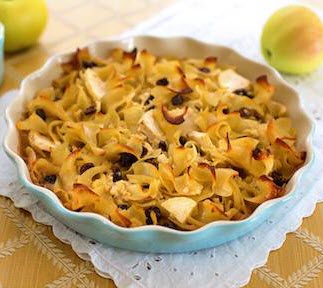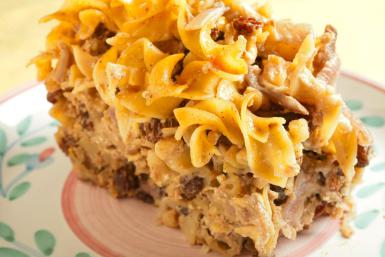  |
KugelKugel is a baked pudding or casserole, similar to a pie, most commonly made from egg noodles (Lokshen kugel) or potato. It is a traditional Ashkenazi Jewish dish, often served on Shabbat and Yom Tov. The name of the dish comes from the Middle High German kugel meaning "sphere, globe, ball"; thus the Yiddish name likely originated as a reference to the round, puffed-up shape of the original dishes. The first kugels were made from bread and flour and were savory rather than sweet. About 800 years ago, cooks in Germany replaced bread mixtures with noodles or farfel.[citation needed] Eventually eggs were incorporated. The addition of cottage cheese and milk created a custard-like consistency common in today's dessert dishes. In Poland, Jewish homemakers added raisins, cinnamon and sweet curd cheese to noodle kugel recipes. In the late 19th century, Jerusalemites combined caramelized sugar and black pepper in a noodle kugel known as "Yerushalmi kugel" or "Jerusalem kugel," which is a commonly served at Shabbat kiddushes and is a popular side dish served with cholent during Shabbat lunch. Kugels are a mainstay of festive meals in Ashkenazi Jewish homes, particularly on the Jewish Sabbath and other Jewish holidays or at a Tish. Some Hasidic Jews believe that eating kugel on the Jewish Sabbath brings special spiritual blessings, particularly if that kugel was served on the table of a Hasidic Rebbe. A similar traditional Belarusian dish is potato babka. Savory kugel may be based on potatoes, matzah, cabbage, carrots, zucchini, spinach or cheese. While noodle kugel, potato kugel, and other variations are dishes served on Jewish holiday meals, matzo kugel is a common alternative served at Passover seders which is adjusted to meet passover kosher requirements.
|